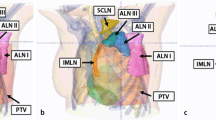Background and Purpose:
The aim of the present paper is to update the practical guidelines for radiotherapy of breast cancer published in 2006 by the breast cancer expert panel of the German Society for Radiooncology (DEGRO). These recommendations were complementing the S3 guidelines of the German Cancer Society (DKG) elaborated in 2004. The present DEGRO recommendations are based on a revision of the DKG guidelines provided by an interdisciplinary panel and published in February 2008.
Methods:
The DEGRO expert panel (authors of the present manuscript) performed a comprehensive survey of the literature. Data from lately published meta-analyses, recent randomized trials and guidelines of international breast cancer societies, yielding new aspects compared to 2006, provided the basis for defining recommendations referring to the criteria of evidence-based medicine. In addition to the more general statements of the DKG, this paper emphasizes specific radiooncologic issues relating to radiotherapy after mastectomy (PMRT), locally advanced disease, irradiation of the lymphatic pathways, and sequencing of local and systemic treatment. Technique, targeting, and dose are described in detail.
Results:
PMRT significantly reduces local recurrence rates in patients with T3/T4 tumors and/or positive axillary lymph nodes (12.9% with and 40.6% without PMRT in patients with four or more positive nodes). The more local control is improved, the more substantially it translates into increased survival. In node-positive women the absolute reduction in 15-year breast cancer mortality is 5.4%. Data referring to the benefit of lymphatic irradiation are conflicting. However, radiotherapy of the supraclavicular area is recommended when four or more nodes are positive and otherwise considered individually. Evidence concerning timing and sequencing of local and systemic treatment is sparse; therefore, treatment decisions should depend on the dominating risk of recurrence.
Conclusion:
There is common consensus that PMRT is mandatory for patients with T3/T4 tumors and/or four or more positive axillary nodes and should be considered for patients with one to three involved nodes. Irradiation of the lymphatic pathways and the optimal time point for onset of radiotherapy are still under debate.
Hintergrund und Ziel:
Ziel der Arbeit ist eine Aktualisierung der 2006 publizierten Leitlinie der „Expertengruppe Mammakarzinom“ der Deutschen Gesellschaft für Radioonkologie (DEGRO). Diese war seinerzeit in Ergänzung zur interdisziplinären S3-Leitlinie der Deutschen Krebsgesellschaft (DKG) von 2004 verfasst worden. Zwischenzeitlich erfolgten eine Überarbeitung und Aktualisierung der S3-Leitlinie der DKG, die im Februar 2008 publiziert wurde.
Methodik:
Die Expertengruppe (identisch mit den Autoren dieses Manuskripts) führte eine umfassende Literaturrecherche durch. Aktuelle Metaanalysen und randomisierte Studien, die neue Aspekte gegenüber 2006 ergaben, sowie Empfehlungen internationaler Fachgesellschaften wurden in die Bewertung von Therapieindikationen einbezogen. Diese orientieren sich an den Kriterien evidenzbasierter Medizin. In Ergänzung zu den eher allgemeinen Statements der DKG 2008 werden spezielle radiotherapeutische Fragestellungen behandelt, die eine Strahlentherapie nach Mastektomie (PMRT) und/oder bei fortgeschrittenen Tumoren, die Bestrahlung der Lymphabflusswege und die Sequenz von Radio- und Systemtherapie betreffen. Zielvolumendefinition und Dosierung werden im Detail beschrieben.
Ergebnisse:
Die PMRT senkt die Lokalrezidivrate bei Patientinnen mit hohem Rückfallrisiko (T3/T4-Tumoren und/oder befallene axilläre Lymphknoten; 12,9% mit und 40,6% ohne PMRT). Je ausgeprägter die durch die Radiotherapie bewirkte lokale Tumorkontrolle ist, desto stärker wirkt sich dies auf die Überlebenswahrscheinlichkeit aus. Bei lymphonodal positiven Patientinnen ergab sich eine absolute Verminderung der tumorspezifischen Sterblichkeit um 5,4% nach 15 Jahren. Hinsichtlich des Nutzens einer Strahlentherapie der Lymphabflusswege ist die Datenlage widersprüchlich. Eine Bestrahlung der Supraklavikularregion ist jedoch bei vier oder mehr befallenen axillären Lymphknoten stets indiziert und sollte bei ein bis drei positiven Lymphknoten erwogen werden. Bezüglich der Sequenz von Radio- und Systemtherapie gibt es keine richtungweisenden Evidenzen zugunsten einer Therapiemodalität. Postoperativ sollte die Sequenz vom dominierenden Risiko abhängig gemacht werden.
Schlussfolgerung:
Nach Mastektomie ist die PMRT bei T3/T4-Tumoren, Resttumor und/oder axillären Lymphknotenmetastasen obligat. Die Bestrahlung der regionalen Lymphabflusswege und die Sequenz von Radio- und Systemtherapie bleiben bei unzureichender Datenlage Gegenstand interdisziplinärer Diskussionen.
Similar content being viewed by others
Author information
Authors and Affiliations
Corresponding author
Additional information
Update: October 2007
Rights and permissions
About this article
Cite this article
Sautter-Bihl, ML., Souchon, R., Budach, W. et al. DEGRO Practical Guidelines for Radiotherapy of Breast Cancer II. Strahlenther Onkol 184, 347–353 (2008). https://doi.org/10.1007/s00066-008-1901-8
Published:
Issue Date:
DOI: https://doi.org/10.1007/s00066-008-1901-8
Key Words:
- Radiotherapy of breast cancer
- Postmastectomy radiotherapy
- Locally advanced disease
- Lymph node irradiation
- Sequencing of local and systemic treatment




